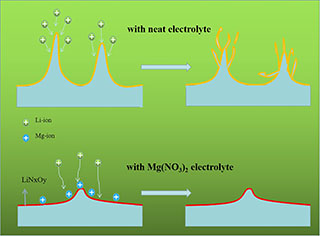

碳酸酯类电解液中Mg(NO3)2添加剂抑制锂枝晶生长的研究
收稿日期: 2020-07-11
修回日期: 2020-11-11
网络出版日期: 2020-12-17
Study on Inhibition of Lithium Dendrite Growth by Mg(NO3)2 Additive in Carbonate Electrolyte
Received date: 2020-07-11
Revised date: 2020-11-11
Online published: 2020-12-17
张彪 , 帅毅 , 王玉 , 杨纳川 , 陈康华 . 碳酸酯类电解液中Mg(NO3)2添加剂抑制锂枝晶生长的研究[J]. 电化学, 2021 , 27(4) : 423 -428 . DOI: 10.13208/j.electrochem.200711
In the lithium-sulfurized polyacrylonitrile battery system, the formation and growth of lithium dendrites in the negative electrode seriously deteriorate the charge and discharge performance of the battery. If the growth of lithium dendrites pierces the separator and causes thermal runaway, it will also bring serious damage to the battery, causing potential safety risks. In the carbonate electrolyte that is more conducive to stabilizing the positive electrode sulfurized polyacrylonitrile material, the growth of lithium dendrites is particularly serious. In this paper, magnesium nitrate was added to the carbonate electrolyte to investigate the combined effect of nitrate and magnesium ions on the surface modification of lithium metal. Studies have found that during the cycle, magnesium ions were reduced on the surface of the lithium negative electrode to form a lithium-magnesium alloy layer, which reduced excessive side reactions between the electrolyte and the negative electrode. The reduction of magnesium ions into magnesium metal could guide the uniform deposition of lithium ions and reduce the formation of lithium dendrites; at the same time, nitrate could form an SEI film with high ionic conductivity rich in nitrogen oxides with lithium ions, which could make lithium ions at the interface that conducts quickly at the location, and under the combined action of the two, the formation and growth of lithium dendrites were inhibited, and the cycle performance of the battery was improved. The experimental data showed that under the combined action of nitrate and magnesium ions, the growth of lithium dendrites was effectively inhibited. When the concentration of magnesium nitrate was 100 mmol·L-1, the coulombic efficiency of the lithium copper half-cell was significantly improved, and the cycle performance of lithium-sulfide polypropylene nitrile battery was also significantly enhanced. The capacity retention rate after 300 cycles was 71%, which was much higher than 61% of lithium nitrate and 50% without additives.

/
| 〈 |
|
〉 |